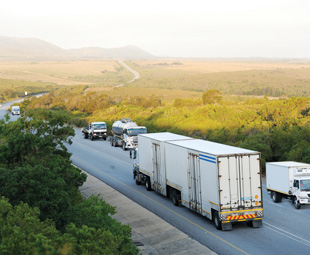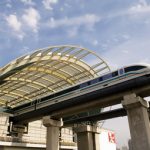Road-friendly vehicles and improved performance

CSIR research has shown that road wear and costs associated with heavy vehicles can be reduced, while increasing safety and productivity, and lowering vehicle emissions.
“Typical challenges of heavy vehicle operations in South Africa include the high rate of crashes; vehicle overloading, which accelerates the deterioration of our roads; congestion; and high logistics costs,” says Paul Nordengen of the CSIR. “The past 10 years saw a 32% increase in freight vehicles on our national and provincial roads. About 15-20% of heavy vehicles currently operating on our roads are overloaded – 60% of the road wear (or damage) caused by all heavy vehicles to our roads can be ascribed to these.”
The traditional approach of law enforcement in the road freight sector is not sufficiently effective. Amendments have been made to the National Road Traffic Act to strengthen the legislation. Other approaches include using the road transport management system (RTMS) and performance-based standards (PBS) approach to heavy vehicle design.
Key elements in the heavy vehicle industry are the design, construction and maintenance of the road infrastructure; the design, maintenance and operation of vehicles; and driver wellness.
“The RTMS is a voluntary, self-regulation scheme that tries to encourage consignees, consignors and road transport operators to implement a management system to contribute to preserving road infrastructure, improving road safety and increasing productivity. It is an industry-led, government-supported initiative that focuses on load optimisation, driver wellness, vehicle maintenance and productivity,” explains Nordengen. He serves on the national steering committee of the RTMS and leads CSIR research in network asset management systems in the roads and transport sectors.
In the sugar industry, applying the RTMS resulted in a 71% reduction in the extent of overloading and a 53% reduction in the degree of overloading within a period of three years. “This industry harvests 21 million tons of sugarcane annually that are transported by about 1 500 trucks,” comments Nordengen.
Performance-based standards
“Most countries control heavy vehicle use on the road network through prescriptive regulations, which does not seem effective in many cases, particularly in developing countries. PBS uses a different approach, specifying the performance required from the operation of a vehicle on a road network, thus what a vehicle can do,” explains Nordengen. Following successful results obtained through PBS in Australia, New Zealand and Canada, the CSIR started a research programme in South Africa. In collaboration with the forestry industry, a number of PBS demonstration vehicles were designed, manufactured and operated to obtain practical experience and quantify and evaluate the potential infrastructure preservation, safety and productivity benefits for road freight transport.
PBS allows more flexibility for vehicle designers to use innovative solutions and the latest technology to meet the required performance standards, resulting in improved safety outcomes and more effective use of the road infrastructure. As vehicles operated under a PBS framework are usually longer and carry heavier payloads, they are limited to travel on a subset of the network to ensure protection of the road infrastructure and acceptable safety levels. “It is important to match vehicles to specific routes. The standard of the road infrastructure varies, with national and provincial roads being most appropriate for PBS vehicles.”
Monitoring and evaluation
“A scientific comparison was done between three baseline vehicles and the PBS vehicles, using the South African mechanistic-empirical design method. Eight typical road designs were used in both wet and dry conditions. Operators of the PBS vehicles were required to be accredited through the RTMS self-regulation accreditation scheme.”
Data was collected and monitored monthly, which has not yet been done elsewhere in countries implementing PBS. Data was obtained on:
• Load per trip
• Average trip speeds
• Kilometres travelled per month
• Average monthly fuel consumption
• Maintenance costs
• Records of incidents and accidents.
“An average wear cost was calculated for the 16 cases (eight pavement types, wet and dry conditions) for each of the baseline and PBS vehicles,” explains Nordengen. The effect of increasing the wheel spacing of the dual tyres on the drawbar trailer was also investigated. “To look at actual cost savings, we calculated the average road-wear costs for each vehicle type in South African cents. Taking into account the different permissible maximum loads on each vehicle, a road-wear cost per km per ton of load transported (c/ton km) was calculated for each vehicle.” The average roadwear costs of the PBS vehicles ranged from 7 to 8.3 c/ton km, while the baseline vehicles ranged between 8.4 and 10.6 c/ton km.
Safety is an important aspect in heavy vehicle operation: baseline vehicles of 22 m long typically carry payloads of up to 35 tons, while the longer PBS vehicles of 24 to 27 m carry up to 46.5 tons. “Safe handling during lane changes, for example, is critical when livestock wanders onto a road in front of a heavy vehicle moving at speed. The PBS heavy vehicles showed a far better performance during high speed transient off-tracking, one of the PBS standards,” says Nordengen. “However, to do a validated scientific assessment of safety performance, we need a minimum of 5 million km of travel data.”
“We are very excited about the initial results. The use of PBS vehicles shows improved productivity and fuel consumption, improved safety performance and a reduction in CO2 emissions,” he notes. “We anticipate that other vehicle and tyre modifications could also be implemented that result in more road-friendly vehicles, without a negative effect on productivity.”
The positive performance of the PBS demonstration project has resulted in the approval of 30 additional permits for such vehicles in the forestry industry, thus expanding the pilot projects specifically for conducting more research on safety aspects. “Due to the successful pilot in the forestry industry, discussions are underway with the sugar cane, coal mining and general freight sectors,” Nordengen concludes.
Published by
Focus on Transport
focusmagsa



